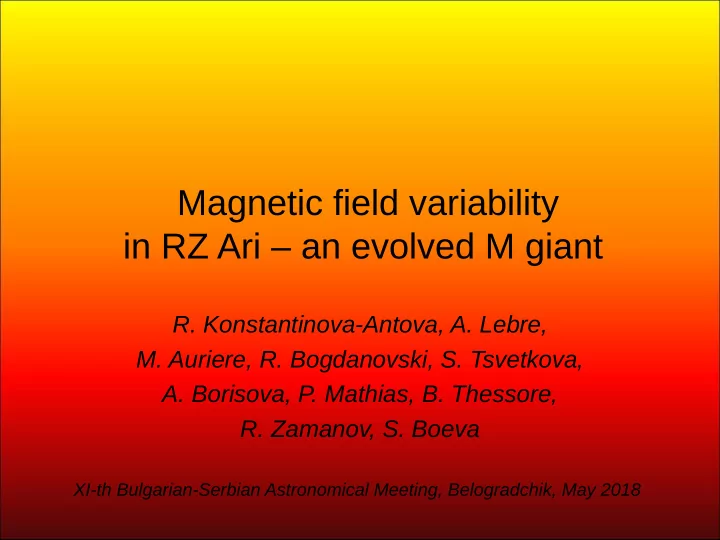

Magnetic field variability in RZ Ari – an evolved M giant R. Konstantinova-Antova, A. Lebre, M. Auriere, R. Bogdanovski, S. Tsvetkova, A. Borisova, P. Mathias, B. Thessore, R. Zamanov, S. Boeva XI-th Bulgarian-Serbian Astronomical Meeting, Belogradchik, May 2018
Introduction M giants weren't known to possess magnetic fields. Nevertheless, the theoretical predictions for dynamo operation on the Asymptotic Giant Branch (AGB), (Soker&Zoabi, 2002; Nordhaus et al. 2008, Brandenburg 2002), the data on magnetic activity in such stars were sparse and indirect (Huensch et al. 1998; Karovska et al. 2005; Herpin et al. 2006). We obtained direct Zeeman detections and measured with a high accuracy the longitudinal magnetic field in single M giants (Konstantinova-Antova et al. 2010; 2013; 2014). Here we present the results of about 10 years magnetic field study of RZ Ari – a single M giant with fast rotation.
Our first sample single M giants The M giants were selected on the basis of their faster rotation (Zamanov et al. 2008) and X-ray emission (Hunsch et al. 1998;2004). These stars were observed with Narval spectropolarimeter since 2008. Data for them are presented below (Konstantinova-Antova et al. 2013). Star Other Name Sp class vsini log Lx Detection Bl max σ km/s G G HD130144 EK Boo M5III 8.5 30.30-31.50 DD -8.10 0.60 HD6860 beta And M0III 5.6 DD -0.95 0.16 HD16058 15 Tri M3III 5.4 30.80 DD 1.19 0.21 HD18191 RZ Ari M6III 9.6 DD 13.01 0.33 HD150450 42 Her M2.5III 2.5 29.41 nd HD167006 V669 Her M3III 5.2 DD -0.90 0.24 HD184786 V1743 Cyg M5III 7.8 nd HD187372 M2III 4.4 30.64 MD 0.54 0.34 HD219734 8 And M2III 4.9 MD -0.93 0.24 RZ Ari is the star with largest Vsini and strongest MF in our sample!
Rotation Konstantinova-Antova et al. 2013
Observations and methods 2-m Bernard Lyot Telescope (TBL),Pic du Midi with NARVAL 2-m Bernard Lyot Telescope (TBL),Pic du Midi with NARVAL spectropolarimeter (Auriere 2003). spectropolarimeter (Auriere 2003). NARVAL was used in polarimetric mode with a spectral NARVAL was used in polarimetric mode with a spectral resolution of about 65000. resolution of about 65000. Stokes I (unpolarised) and Stokes V (circular polarization) Stokes I (unpolarised) and Stokes V (circular polarization) parameters were obtained. parameters were obtained. The extraction of the spectra was performed using Libre-ESpRIT The extraction of the spectra was performed using Libre-ESpRIT (Donati et al. 1997), a fully automatic reduction package installed (Donati et al. 1997), a fully automatic reduction package installed at TBL. at TBL. For the Zeeman analysis, Least-Squares Deconvolution (LSD, For the Zeeman analysis, Least-Squares Deconvolution (LSD, Donati et al. 1997) was applied to all the reduced spectra. Donati et al. 1997) was applied to all the reduced spectra. Bl is measured on the basis of Stokes V and I profiles (Riess & Semel 1979).
RZ Ari = HD 18191: Sp class: M6 III Teff=3450 K, log (L/Lsun) = 3.11 Vsini = 9.6 km/s M ~ 2.2 Msun => either tip RBG or AGB (Konstantinova-Antova et al. 2010)
RZ Ari – additional data: SRb variable star - P~50d; LSP~480d (Percy et al. 2008; 2016; Tabur et al. 2009) Angular diameter d – 0.01022 arcsec (Richichi et al.2006) Distance r – 107.76 pc (Hipparcos; van Leeuwen, 2007) R*= tg (d/2) x r = 117.2 Rsun – consistent with AGB phase
RZ Ari – Bl variability Sept. 2008 – Jan. 2018
RZ Ari – period: Lomb-Scargle 1310 days, +85/-73 days, fap 0.3% LSP identified: 498d +8/-5d fap 35%
RZ Ari – phased Bl variability: P= 1310 d
Future prospects: - ZDI for RZ Ari - identification of the LSP contribution to the MF variability; - further quasi-simultaneous observations – spectropolarimetry + photometry desirable
Discussion 1.Where early AGB stars stand in the context of the MF evolution: After MS in intermediate mass stars convective envelope begins to develop. MFs are detected in Hertzsprung gap stars, at the base of the RGB and He-burning region on HRD and in tip RGB/ early AGB stars. Two reasons for their MF – either dynamo or Ap star descendants (Konstantinova-Antova et al. 2013; Auriere et al. 2015; Charbonnel et al. 2017). Later stage – AGB pulsating stars (Mira type star chi Cyg, Lebre et al. 2014). Weak MFs near max brightness detected as a result of shock wave propagation Work hypothesis: early AGB stars are a case of transition between pure dynamo generated MF and shock wave compressed one
2. What we know about LSP? (Percy et al. 2016) LSP ~ 8.1 +/- 1.3 times the excited pulsation period No evidence for more than one LSP in each star Multicolor photometry showed that LSP color variations are similar to those of pulsation P The amplitudes vary by a factor of two on a timescale 20-30 LSP Eventual mechanisms for LSP suggested: -the turnover of giant convective cells -oscillatory convective modes -dusty cloud orbiting the red giant - rotation modulation due to spots
• What could be concluded: • In many cases Prot > LSP • Color variations similar to those in the pulsation • Sine shape variability from photometry • No evidence for giant convective cells in magnetic M giants (contrary to the supergiant Betelgeuse, Auriere et al. 2016; Mathias et al. 2018, in press) • RZ Ari not known as binary star • Conclusion: LSP rather possible to be related to the pulsations than other reasons mentioned above
Do we observe an interplay between dynamo and pulsations in RZ Ari?
Long-term variability in other sample stars:
Acknowledgements: We thank the TBL team for the service observing. The observations are granted with observational time under two OPTICON projects for semesters 2008B and 2011B, the Bulgarian NSF project DSAB 01/3 in 2010, the EU project BG 051PO001-3.3.06-0047 in 2012 and 2013, and the French PNPS program for the period 2015-2018. R.K.-A., R.B. and S.Ts. acknowledge partial financial support under Bulgarian NSF contract DN 18/2.
Thank you for your attention!
Recommend
More recommend